
The Mimosoideae are a traditional subfamily of trees, herbs, lianas, and shrubs in the pea family (Fabaceae) that mostly grow in tropical and subtropical climates. They are typically characterized by having radially symmetric flowers, with petals that are twice divided (valvate) in bud and with numerous showy, prominent stamens.

Cercis is a genus of about 10 species in the subfamily Cercidoideae of the pea family Fabaceae. native It contains small deciduous trees or large shrubs commonly known as redbuds in the USA. They are characterised by simple, rounded to heart-shaped leaves and pinkish-red flowers borne in the early spring on bare leafless shoots, on both branches and trunk ("cauliflory"). The genus contains ten species, native to warm temperate regions of North America, southern Europe, western and central Asia, and China.

Abarema is a neotropical genus in the family Fabaceae. It is native to Brazil, Cuba, and Venezuela. Most of the species can be found in the Amazon Basin and the Guyana Highlands. They have a deep-green fernlike foliage, with bipinnately compound leaves.

Abarema abbottii, the Abbott abarema, is a species of plant in the family Fabaceae. It is found only in the Dominican Republic, and is confined to broad-leaved woodlands on limestone soils.

Cojoba is a genus of flowering plants in the family Fabaceae. It includes 15 species, which range through the tropical Americas from northern Mexico through Central America and the Caribbean to Bolivia and northern Brazil. from
Hydrochorea is a genus of flowering plants in the family Fabaceae. It includes 11 species native to Central and South America and west and west-central Africa. It belongs to the mimosoid clade of the subfamily Caesalpinioideae.
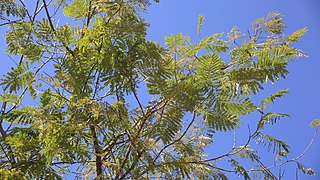
Leucochloron is a genus of flowering plant in the family Fabaceae. It includes four species native to Brazil. It belongs to the mimosoid clade of the subfamily Caesalpinioideae.

Macrosamanea is a genus of flowering plant in the legume family, Fabaceae. It includes 11 species of trees and shrubs native to northern South America. The genus is most diverse and numerous in the Amazon Basin, extending into the Orinoco basin and the Guianas. Typical habitat is tropical rain forest, mostly riparian and seasonally-flooded. Two species are native to seasonally-inundated wooded grassland (savanna) on sandy soils. The genus belongs to the mimosoid clade of the subfamily Caesalpinioideae.
Macrosamanea macrocalyx is a species of flowering plant in the family Fabaceae. It is found only in Brazil.
Orphanodendron is a genus of legume in the legume family, Fabaceae. It includes two species of trees native to Colombia, which grow in tropical lowland forest. The genus is in subfamily Faboideae.
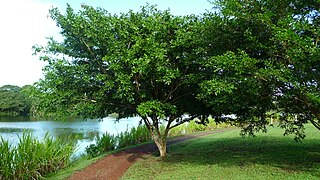
Zygia is a genus of flowering plants in the family Fabaceae. It includes 60 species of tres and shrubs native to the tropical Americas, from Southern Mexico and Cuba to northern Argentina. Typical habitats are tropical forest and coastal zones, generally below 900 meters elevation with a few species extending up to 2800 meters. It belongs to the mimosoid clade of the subfamily Caesalpinioideae.

Punjuba is a genus in the family Fabaceae. It is native to Costa Rica, as well as to western South America.
Pseudosamanea is a genus of flowering plant in the family Fabaceae, native from southern Mexico to Venezuela and Ecuador, and to Cuba. The genus was established in 1930.
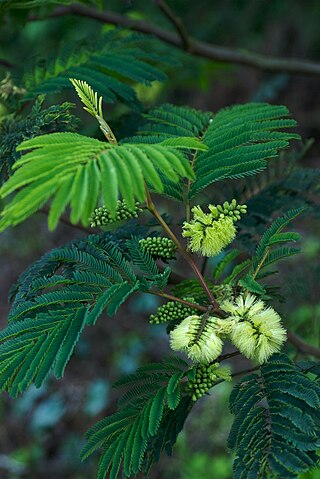
Paraserianthes lophantha, the Cape Leeuwin wattle, Bicol wattle, Cape wattle, crested wattle or plume albizia, is a fast-growing tree with creamy-yellow, bottlebrush like flowers. It is the sole species in genus Paraserianthes.

Falcataria is a genus of flowering plants in the family Fabaceae. It belongs to the monophyletic Mimosoid clade in the subfamily Caesalpinioideae. The genus has three species previously classified in the Falcataria section of the genus Paraserianthes by I.C. Neilsen. The distribution of these closely related species within the genus Falcataria links the wet tropics of north-east Australia to New Guinea, the Moluccas, Bismarck Archipelago, and the Solomon Islands east of Wallace's line similar to other plant taxa from the region.
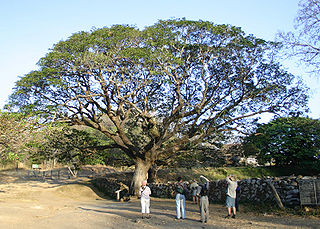
Samanea is a genus of flowering plants in the family Fabaceae. It includes four species of trees native to the tropical Americas, ranging from Belize to Paraguay, and to the Democratic Republic of the Congo in central Africa. Habitats include tropical moist evergreen and seasonally-dry deciduous forest, woodland, and wooded grassland. It belongs to the mimosoid clade of the subfamily Caesalpinioideae. The type species is Samanea saman from South America.

Abarema adenophora is a species of plant in the family Fabaceae. It is native to Northern South America, Costa Rica, and Nicaragua.
Abarema levelii is a species of plant of the genus Abarema in the family Fabaceae. It is native to Venezuela and north Brazil.
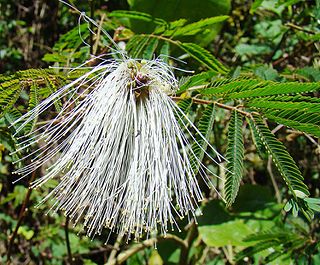
Hydrochorea elegans is a species of flowering plants in the family Fabaceae. It is a tree in the emergent layer of the tropical rainforest of southern Central America and northern South America. The species was formerly known as Balizia elegans, and reassigned to genus Hydrochorea in 2022.
James Walter Grimes, known as Jim Grimes, is an American botanist.













